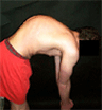
Scheuermann's disease, also referred to as juvenile kyphosis or
vertebral epiphysitis, is a structural deformity characterized
by anterior wedging of 5 degrees or more of three adjacent
thoracic bodies (1). Scheuermann's disease occurs more often in
males than females, is most diagnosed between the ages of 12 and
16, and is associated with increased levels of growth hormone
(individuals with the disease are often taller than average)
(2,1). The prevalence of Scheuermann's disease is thought to be
between 0.4% and 8% (3).
Scheuermann's disease is likely autosomal dominant, which means
that a child only needs to inherit one abnormal gene from one
parent to display the disease (1). The etiologic factors and
pathogenesis of the condition are unknown (1).
Clinical Manifestations
Doctors rely on both clinical examination and radiographic
imaging to diagnose Scheuermann's disease. Adolescents with
Scheuermann's disease are often asymptomatic (3,1). An estimated
20% of patients with Scheuermann's disease present with dull,
aching, intermittent pain in the kyphotic curve, fatigue, and
spinal tenderness or stiffness (3,1). Low back pain afflicts as
many as 80% of patients with Scheuermann's disease (3). Patients
may exhibit an exaggerated thoracic kyphosis, prominent
vertebral spinous processes, tight pectoral, hamstring, and hip
flexor muscles, a more pronounced anterior pelvic tilt, and a
more pronounced lumbar lordotic curve (1). Imaging will reveal
anteriorly wedged vertebrae, vertebral endplate narrowing,
irregular vertebral endplates, and Schmorl's nodes (1).
Treatment
Treatment of Scheuermann's disease depends on the severity of
the curve, the progression of the curve, the age of the patient,
and the severity of the symptoms (1). If diagnosed during the
adolescent years, treatment focuses on preventing the
progression of the deformity and may include postural exercise,
stretching, thoracic hyperextension, soft tissue and joint
mobilization, traction, exercises to strengthen abdominal and
gluteal muscles, and bracing (2, 1). Researchers suggest that
flexible curves are a positive predictor of successful bracing
outcomes (3). A 2003 study of the duPont kyphosis brace
concluded that the brace needs to be donned until skeletal
maturity (or at least 16 months) in order to halt disease
progression or improve the curve (3). NSAIDs and temporary rest
from aggravating physical activity typically alleviate pain from
Scheuermann's disease (3).
If curves are severe, progressive, or cause progressive
neurologic symptoms and severe pain, surgical management may be
warranted (1). If a curve greater than 75° is present alongside
severe pain that is unresponsive to conservative treatment, an
orthopedic surgeon may perform a spinal fusion (3). Cord
decompression may be indicated if neurologic deficits are
present (3).
|






